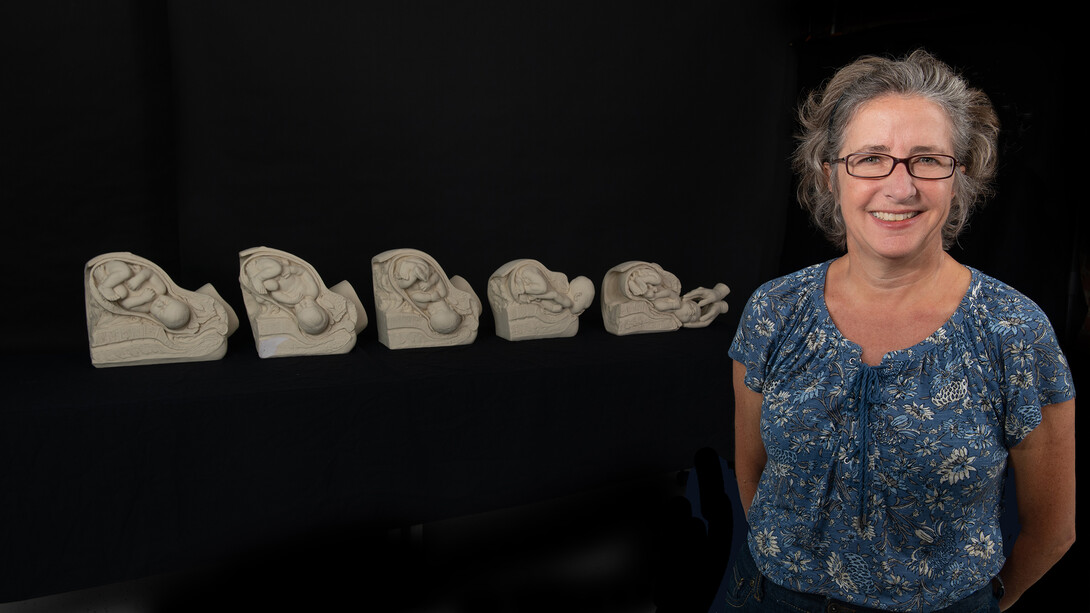
When Rose Holz first researched Dr. Robert L. Dickinson, a pioneer of maternal health care, she never expected to still be fascinated decades later.
Holz was a graduate student writing her dissertation on the birth control movement the first time she learned about Dickinson, who practiced obstetrics and gynecology in the United States in the first half of the 20th century and was an advocate for prenatal health care. Later, she learned he also produced, along with sculptor Abram Belskie, the Birth Series — sculptures depicting stages of pregnancy from conception until birth. Exhibited at the 1939-40 World’s Fair in New York City, it’s estimated that more than 700,000 people viewed them, often waiting in long lines.
The discovery that the University of Nebraska State Museum had purchased and displayed its own set of the Birth Series from the 1950s through the early 1970s in the Ralph Mueller Health Galleries spurred Holz, then an associate professor of practice in women’s and gender studies, to begin a new line of research into Dickinson. Since, she’s given more than a dozen talks and published an article and several book chapters about Dickinson’s contributions to obstetrics and health care communication. She was recently interviewed for a Smithsonian Magazine piece on Dickinson, and her latest chapter was included in the new anthology Rethinking the Public Fetus: Historical Perspectives on the Visual Culture of Pregnancy.
“The most fascinating for me was the inclusion in an anthology of historians of art and medicine, which put me in a whole other world,” Holz said. “It’s been interesting to see the different places that these pieces are finding themselves — including among an international group of scholars on the cutting edge of reproductive studies.”
And now, she’s furthering knowledge about Dickinson through a new project with the University of Nebraska–Lincoln’s Center for Digital Research in the Humanities — digitizing the six editions of Dickinson’s Birth Atlas.
The Birth Atlas was a book of photographs of the Birth Series and written explanations of what the photos were showing. It was used as a teaching tool for decades. The Birth Atlas was so popular, it was printed into the 1990s, though its usefulness in medical libraries had waned. Still, they are in the collections of medical history libraries all over the world.
“As ubiquitous as this imagery was, and as these books are, they have never made it into the digital record,” Holz said.

Holz has received permission to do the project, and she is currently working with Amy Heberling, borrowing and resource sharing associate with University Libraries, to track down copies through interlibrary loan. Once she has copies of the six editions, she’ll begin the work of digitization and annotation. She expects to find and unravel more mysteries. She knows there are changes and updates among the editions, for varying reasons.
“For example, plate 5 in the first edition is from the first set of Birth Series sculptures Dickinson made in consultation with medical artist Vladimir Fortunato, who died during the project,” Holz said. “In the second edition, however, plate 5 reflects the arrival of Belskie and the subsequent reimagining of this sculpture to be fully 3D, which then became part of the second series they made for the reopening of the NYC World’s Fair in 1940. It’s the Rosetta stone to distinguish between the original two sets. Other changes came in subsequent editions. They have more imagery because new science and new technology began supplementing the visual story of the sculptures.
“Every time I look at them, or someone else looks at them, we notice something different, and we’ll be looking for more information. Whether or not we can find it, I don’t know yet.”
Holz also thinks a lot about another series of pregnancy sculptures Dickinson and Belskie did together.
“In consultation with Dickinson, Belskie did a series of breech birth sculptures that are not in the atlases, though they do appear in another book from 1966 called ‘A Baby Is Born: The Picture of a Baby from Conception Through Birth,’” she said. “These are really unknown, though.”
The research into Dickinson also led Holz to offer a new course, Pregnancy in Medicine, Law and Society in the Past and Present, where students examine pregnancy through a variety of historical and contemporary lenses, from the 1700s to the present.
Holz thought several years ago that she was done with Dickinson, but new opportunities and uncanny coincidences — including a conversation with a neighbor who found a Birth Atlas in her attic — have kept her engaged in the work.
“I go back to this weird feeling I have that I was meant to find [the sculptures] here,” she said. “I have other projects I am working on, and I still find myself coming back to this.”
And that’s OK with Holz, because even though Dickinson also held problematic views, there’s a complicated history and questions that need to be explored “about medical ethics and eugenics. And discussions about the Birth Atlas allow us to have these important conversations.”
She further added that “his work was a bridge between Sigmund Freud and Havelock Ellis in the early 20th century and Alfred Kinsey in the 1950s and Masters and Johnson in the 1960s. He was smack in the middle of all these movements in the first half of the 20th century.” And in anything written by scholars about women’s health and sexuality in the first half of the 20th century in the United States, “Dickinson has a cameo.”
Despite his significance, most people still don’t really know about him. That is starting to change. Holz is already organizing a roundtable with other historians about the complexities of Dickinson’s life and legacy for the 2025 conference of the American Association for the History of Medicine.







